Comleam
Software for modelling runoff and leaching from components or buildings to the environment. COMLEAM is available free of charge and is supported by OST - Ostschweizer Fachhochschule, Switzerland.
Software for modelling runoff and leaching from components or buildings to the environment. COMLEAM is available free of charge and is supported by OST - Ostschweizer Fachhochschule, Switzerland.
Buildings are intensively exposed to the weather and substances are released to the environment by precipitation. The emissions often affect small water bodies in urban areas. For example, the leaching of biocides used in paints, plasters and wood preservatives is well known.
The simulation model COMLEAM (COnstruction Material LEAching Model) is developed in order to assess the leaching of substances and the environmental risk. COMLEAM takes into account real weather data and calculates the surface runoff as well as the wind driven rain at facades. Further factors affecting release and environmental impact are included in the calculations, e.g. building height, orientation, product and substance properties.
The user-friendly software COMLEAM calculates the transport path from weather-exposed components to receiving surface waters. The water and substance flow from construction products, buildings and settlements to water bodies is considered. Inorganic or organic substances can be freely integrated and their impact to water quality over the exposure period be determined.
With the software various requests can be addressed, e.g.
COMLEAM has been used in many projects and students thesis and in several workshops addressing people of industry, authorities and science.
Relevant factors influencing the released amount are the material and substance properties as well as water contact time (precipitation, wind direction, speed). The dynamic calculation of the water flux is taking into account at vertical components the wind driven rain WDR (e.g., facades) and on horizontal surfaces the runoff (e.g. flat roofs). Runoff coefficients can be defined individually for all components. The substance release is accounted for as a function of the water quantity. The user can specify the output quantities, material properties and emission functions if required. Implemented datasets (weather, geometries, emission functions, etc.) allow uniform simulations for substance and product evaluations.
COMLEAM considers weather, geometry and material data for exposure assessments.
COMLEAM is available free of charge as a desktop version for single-user installation or as a web application. Access to the web application is possible with all devices (PC, tablet, smartphone). The features are identical for both versions, but the desktop version guarantees the highest level of confidentiality for sensitive data. The software is realized in Java and Angular. It provides an interface to GIS.
Download desktop app COMLEAM V 3.0
The download is password protected. To get your login, please contact info@comleam.com. Download all files and place all files in the same directory. The installation is started by double clicking on 'Setup'.
Current information on projects, lectures, events or student research projects, predominantly linked to information on the use of COMLEAM, are listed here.
From 30.03 to 31.03 this year's Fresenius Online Conference on Environmental Risk Assessment of Biocides will take place, and the COMLEAM team will also be participating.
Another and probably last time the ESTIMATE group met in Rapperswil to exchange information about current projects, to network and to work on common project ideas.
COMLEAM has been used to determine the discharge and fate of biocideand residuals to stormwater retention pond sediments. Read the full paper here: Linke_et_al_2022_hydrology_research.pdf
At the beginning of 2022, the new project for emission-based product assessment of wood coatings (EmbaPro Holz) started.
The findings of the ESTIMATE group meetings were published.
Emissions from building materials – a threat for the environment?
In this paper, we show the extent of emissions induced by rain events in two study sites in Berlin.
There is only limited knowledge about the pollutants that leach out of building materials used for new constructions in urban and redevelopment areas. These substances can potentially lead to concentrations, which exceed environmental quality standards in urban soils and urban-influenced waters and...
New project started concerning groundwater discharges of biocides from facades in urban regions
A paper on biocides in facades has been published, describing ways to avoid and reduce biocide use on facades.
We had the pleasure of presenting COMLEAM at the 7th International Fresenius Conference on Environmental Risk Assessment of Biocides.
The manual for the new COMLEAM Version 3.0 is ready and will be available for download from September 14, together with the new COMLEAM version 3.0. The documentation is fully written in english.
Development of an emission-based method for the assessment of substance leaching from building materials.
The new COMLEAM Version 3.0 will be available online and for local download from September 14.
Since 1st September 2020, HSR University of Applied Sciences Rapperswil has been turned into Eastern Switzerland University of Applied Sciences (OST).
At 28th August 2020, the final presentation of the project "Concept for emission based construction product assessment" will take place at HSR.
On June 18th, an online ESTIMATE group meeting took place, attended by RWTH, BAM, RMI and HSR.
The new COMLEAM version 2.5 is under development. The new version fixes numerous small bugs and increases the performance of the application.
Am 14. Januar 2020 startete in Basel die grösste Baumesse der Schweiz, die Swissbau. Die HSR Rapperswil war zusammen mit dem Büro für Umweltchemie BFU vor Ort.
A meeting of the CEN/TC 351 Working Group 'Construction products: Assessment of release of dangerous substances' was held in Vilnius (LT) from 16 to 17 October.
From the 04.11 the COMLEAM web app will be password protected. To get your login, please contact info@comleam.com
Beim „31. Hamburger Kolloquium zur Abwasserwirtschaft“ stehen die Themenblöcke Mikroschadstoffe/ Mikroplastik sowie das Management von Niederschlagswasser im Vordergrund.
Am 12./13. September 2019 findet an der HSR Hochschule für Technik ein internationaler Workshop statt. Ziel ist, die neuen Funktionalitäten, Szenarien und Web-Version vorzustellen.
Unter dem Motto "Regenwasser weiterdenken - Bemessen trifft Gestalten" werden Konzepte zur Retention und Nutzung von Regenwasser vorgestellt.
Lukas Füglister, Masterstudent, hat seine Projektarbeit "Konzept zur Auswertung von Geodaten digitaler Oberflächenmodelle und deren Aufbereitung als Eingabedaten für das Simulationsmodell COMLEAM" fertiggestellt.
Die Arbeitsgruppe ESTIMATE hat sich bei der BAM in Berlin getroffen und die Herausforderungen der Modellierung im Bereich von der Auslaugung und dem Eintrag in Boden und Gewässer diskutiert.
Ab sofort sind Neuigkeiten rund um die Anwendung von COMLEAM hier zu finden. Gratis-Zugang zur Web-Version und kostenlose technische Unterstützung werden über diese Seite angeboten.
Groundwater pollution of biocides from facades in urban regions (GRUBURG)
The leaching of biocides from coatings for roofs and façades due to precipitation may cause pollution of stormwater runoff in urban areas and transfer of the active compounds into soil, groundwater and surface water. Various studies have shown that the emission of biocides and their transformation products at the building, the transfer pathway and the input into soil and groundwater are influenced by different factors. The present project will (1) develop an urban scenario for the worst-case assessment of biocide leaching from roofs and facades into groundwater, (2) compare the relevance of urban biocide inputs into groundwater with those of pesticides from agriculture, and (3) develop a practice-oriented, policy-based guideline for communities to avoid or reduce unintended substance inputs into groundwater. A broad review of relevant soil properties in urban areas will be compiled for the scenarios. Biocide emissions will be considered in relation to, for example, building geometry, exposure area and site-specific weather conditions. Representative surface types will be identified, that serve as entry for the substances to pass the soil and finally reach the groundwater. Here, partially sealed surfaces and structures of urban stormwater infiltration receive particular attention.The scenarios are subsequently analysed for their suitability in FOCUS models (PEARL, PELMO, etc.) by performing benchmark simulations. Finally, a suitable model is selected by comparing model results with those of groundwater simulations and existing field data. A literature survey will collect existing knowledge on pesticides and biocides in Germany and various European countries. For example, different active substances, entry routes (e.g. point and non-point sources) and end points of contamination (surface water, groundwater) will be distinguished. Refined and target-oriented measures at the source (source-control) and end-of-pipe will be proposed, scrutinized and included into an action guide for communities. An electronic decision support tool will also be provided.
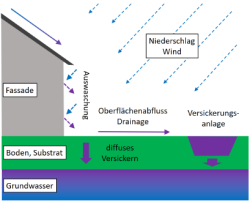
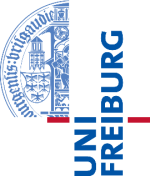

Development of a façade protection system with reduced use of biocides and of a rainwater treatment installation using mixed absorbers for the reduction of substance emissions from urban areas into water bodies (SpuR).
In this project, two new types of technical measures are implemented to reduce emissions of substances from building materials into the environment. One at the source and one at end-of-pipe. In the measure at the source, the environmental impact of a new façade coating with fewer biocides compared to a conventional coating is investigated. The innovative coating system does not contain any slowly degradable algaecides used in conventional film protection. In the end-of-pipe measure, dissolved organic substances as well as particles and metals) are retained in a decentralised rainwater treatment plant with a new adsorber technology.
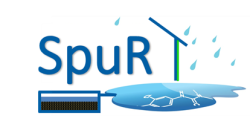


Emission-based product evaluation (EmBaPro)
The leaching of heavy metals, biocides and other additives can be relevant for the environmental impact of building products - and thus for their life cycle assessment. The aim of the project is to develop a standardised method for measuring and assessing pollutants from building materials over their entire life cycle. Possibilities and procedures are defined, how an extrapolation of the emissions from building is possible over the entire service life and with which scheme an integration of the products into labels is possible.



Leaching of metal surfaces and release into groundwater - literature research and measurements under consideration of three urban pesticides (MEDAUG)
Literature and groundwater data were reviewed and supplementary measurements were carried out for the leaching of copper and zinc surfaces and their input into groundwater by percolating rainwater. For groundwater, the pesticides Terbutryn, Diuron and Mecoprop used in buildings were also included.
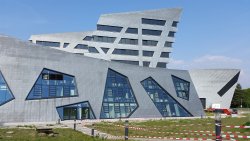
Leaching tests for construction products: Modelling and implementation for the Blue Angel certificate
On the one hand, eluates from roofing membranes will be investigated in biotests with aquatic organisms in order to advance the identification of the leaching behaviour under the 'Blauer Engel' label. On the other hand, proposals for European emission and environmental exposure scenarios for model-based environmental assessment of building products will be developed and simulated with COMLEAM.


Building and Refurbishment as a Pollutant Source in the Urban Environment: Guidance for Regulation and Actors (BaSaR)
How substances from new construction and refurbishment areas are released into the aquatic environment is only known in part. Therefore, it is not possible to estimate the risks for soil and water in urban areas. With leaching tests in the laboratory, investigations at two sites in Berlin and modelling with COMLEAM, it is clarified from which building products relevant substance inputs reach soil and water via rainwater. The measures are intended to change sustainable construction and renovation over the use phase of the life cycle of a building in such a way that the requirements for groundwater and surface water in the urban environment are met.
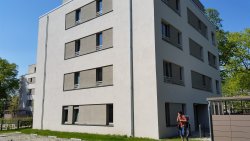


Root-resistant bitumen membranes: Test and evaluation procedures for leaching
Chemical anti-rooting agents are used against the root penetration of bitumen membranes. In the presented project, a methodology was developed to estimate the possible pollution in precipitation water and to derive the need for treatment on the basis of simple, harmonised laboratory tests. The three defined pollution classes (low, medium, high) are based on the system for rainwater pollution according to the VSA guideline "Wastewater management in rainy weather".

Modelling the leaching of biocides from materials and environmental exposure with COMLEAM software (MODCOM)
In the project, COMLEAM is used to calculate leaching and water pollution using both a BPR-compliant procedure (ESDs) and dynamic simulation. For this purpose, BPR emission scenarios (urban and rural scenarios) were implemented in the software code for product type (PT) 7 to 10. In addition, automated reporting with the relevant results was integrated and simulation calculations for exemplary selected European sites for leaching and discharge into surface waters were implemented. An exposure analysis of the emissions in comparison with numerical requirements (exposure classification) and comparative statistical analysis of selected parameters to clarify the transferability of the model results (sensitivity analysis) complete the project.

Here you will find technical articles, reports and presentations for download.
Emissions from Building Materials—A Threat to the Environment?
Article (english)
ESTIMATE paper: Environmental Impact of Construction Products on Aquatic Systems—Principles of an Integrated Source–Path–Target Concept
Article (english)
Biocidal products - Entry into the aquatic environment: Consumption levels of biocidal active substances in protective agents, antifouling and in the veterinary field
Article (German)
COMLEAM Software: Leaching and Environmental Exposure Modelling, Fresenius Conference 2018
Presentation
Emission and transfer functions for the modelling of leaching from construction products
UBA Report 28/2018 (German)
Modelling trace substances' release from buildings and the input into water bodies during rainy weather
conference transcript
Biocides for the protection of coatings: What are the challenges? SVLFC Technology Day Rapperswil
Presentation (German)
Pollution classes and performance testing of technical rainwater treatment plants (adsorbers), VSA sewerage forum
Presentation (German)
COMLEAM is developed and supported by the following institutes of OST - Ostschweizer Fachhochschule in Rapperswil, Switzerland




For technical questions regarding the software and the use of COMLEAM, please contact: support@comleam.com
For specific questions on the suitability of COMLEAM for exposure modelling or product assessment, please contact: info@comleam.com or michael.burkhardt@ost.ch
OST - Eastern Switzerland University of Applied Sciences
Oberseestrasse 10
8640 Rapperswil
Switzerland